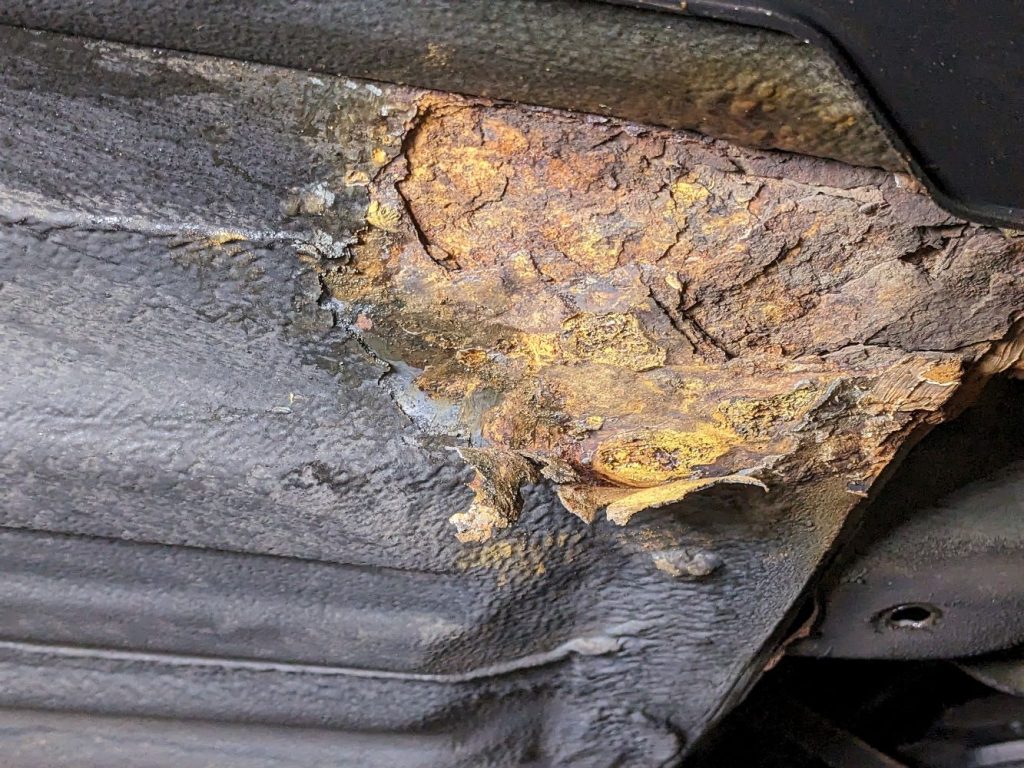Part 2, A Cautionary Tale
I’ll share some thoughts here since it’s a common question I get alongside the lanolin wet film undercoating option (see article Can Lanolin Vehicle Undercoating Help to Stop Rust?). I’ll start with the bottom lines at the top again: Outside of brand new vehicles or full frame-off restorations, I generally would not recommend using rubberized or other paint-on undercoating that dries when finished (I’ll refer to this as a “paint” coating heretofore). Even in those specific scenarios where I think a paint undercoating could be helpful for some time, they have some significant potential downside in the long run. They have a higher risk of causing accelerated corrosion once any moisture finds a way behind the coating.

The above photo is an example of a rubberized/paint-type undercoating failure point I encountered recently, peeled back to show the hidden trapped rust. This is completely rusted through, could push right through it with a finger—one of about six places on this vehicle where it had rusted completely through from moisture retention behind the undercoating. I see this commonly with rubberized/paint-type coatings. Having seen this many times on undercoated vehicles — from OEM to aftermarket-applied — it looks to me like any paint coating is susceptible to this outcome after some amount of time.
The main problem is that paint coatings can become a net-negative liability if they get scratched, worn, or miss even a tiny spot of bare metal. This will happen at some point—maybe on day 3 during the oil change on your mechanic’s lift, or year 3 when you ran over that weird thing on the highway, or later if you’re lucky. But as soon as it allows even a tiny amount of moisture to creep through and start oxidation, the paint coating is now working to seal that moisture inside and accelerates the corrosion process.
Furthermore, even if you have a high quality paint coating applied, it’s impossible for a paint gun to ‘see’ every possible angle to every surface under your vehicle. But water and salt spray will swirl its way up into every nook and cranny, including on top and inside of the underparts of your vehicle. So even in the best case, there’s a risk that moisture finds its way behind the edges of your painted undercoating over time.
Paint coatings are also much more costly to apply properly, so the ROI (return on investment) bar is higher than a wet film undercoating. Especially in the case of a used car with any amount of existing rust or grease, sandblasting, washing, and other time-intensive prep is needed to get a quality application.
I would also apply most of the same assessment with consideration to ‘rust-converter’ or ‘rust-encapsulator’ products. Even sealed or painted over, they have the same problem as any other drying paint product. Any trace of rust that is left unconverted, or encapsulated under a hard/dry coating still remains susceptible to moisture that will find its way behind a dry coating over time. And once moisture is behind, any dry coating is now serving the opposite goal as it retains moisture and accelerates corrosion.
Coating the inside of frame rails or unibody structure can be another problem for paint-type coatings:
- Spraying inside frame rails is a blind operation with any coating product, but even more difficult or impossible to apply a paint-type coating perfectly.
- Too much coating and you’ll seal up smaller moisture exit points (oil coating can flow or flush out to follow and coat egress paths continually).
- Not enough coating, or miss spots, and you have exposed ingress points which will allow moisture to creep in and cause accelerated rust conditions.
Paint-type coatings are not forgiving with follow-up re-application or touch-up of any scratches or other gaps in coverage. For clean application and adhesion, paint-type coatings require full removal of any trace of rust, and cleaning of any grease or dirt. This kind of cleaning and prep is also effectively impossible inside of frame rails. Wet film can be easily restored or improved with additive re-application — just spray new oil on top of the old oil.
While there may be cases in which a paint-type undercoating can be a net positive for some time, I’d say just a wet film undercoating is the best defense against rust. Especially here in the salt belt, it’s an easy net-positive ROI recommendation to extend the life and preserve the value of our vehicles, new and old.

